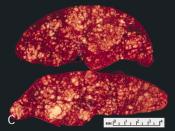What is Hodgkin's disease?
Hodgkin's disease is a type of lymphoma. Lymphomas are cancers that develop in the lymphatic system, a part of the body's immune system. The job of the lymphatic system is to help fight diseases and infection.
The lymphatic system includes a network of thin tubes that branch, like blood vessels, into the tissues throughout the body. Lymphatic vessels carry lymph, a colorless, watery fluid that contains infection-fighting cells called lymphocytes. Along this network of vessels are groups of small, bean-shaped organs called lymph nodes that filter the lymph as it passes through the nodes. Clusters of lymph nodes are found in the underarm, groin, neck, and abdomen. Other parts of the lymphatic system are the spleen, thymus, tonsils, and bone marrow.
Like all types of cancer, Hodgkin's disease affects the body's cells. Healthy cells grow, divide, and replace themselves in an orderly manner. This process keeps the body in good repair.
In Hodgkin's disease, cells in the lymphatic system grow abnormally and can spread to other organs. As the disease progresses, the body is less able to fight infection.
The most common symptom of Hodgkin's disease is a painless swelling in the lymph nodes in the neck, underarm, or groin. Other symptoms may include fevers, night sweats, tiredness, weight loss, or itching skin. However, these symptoms are not sure signs of cancer. They may also be caused by many common illnesses, such as the flu or other infections. But it is important to see a doctor if any of these symptoms lasts longer than 2 weeks. Any illness should be diagnosed and treated as early as possible, and this is especially true of Hodgkin's disease.
If Hodgkin's disease is suspected, the doctor will ask about the patient's medical history and diagnose them by...


